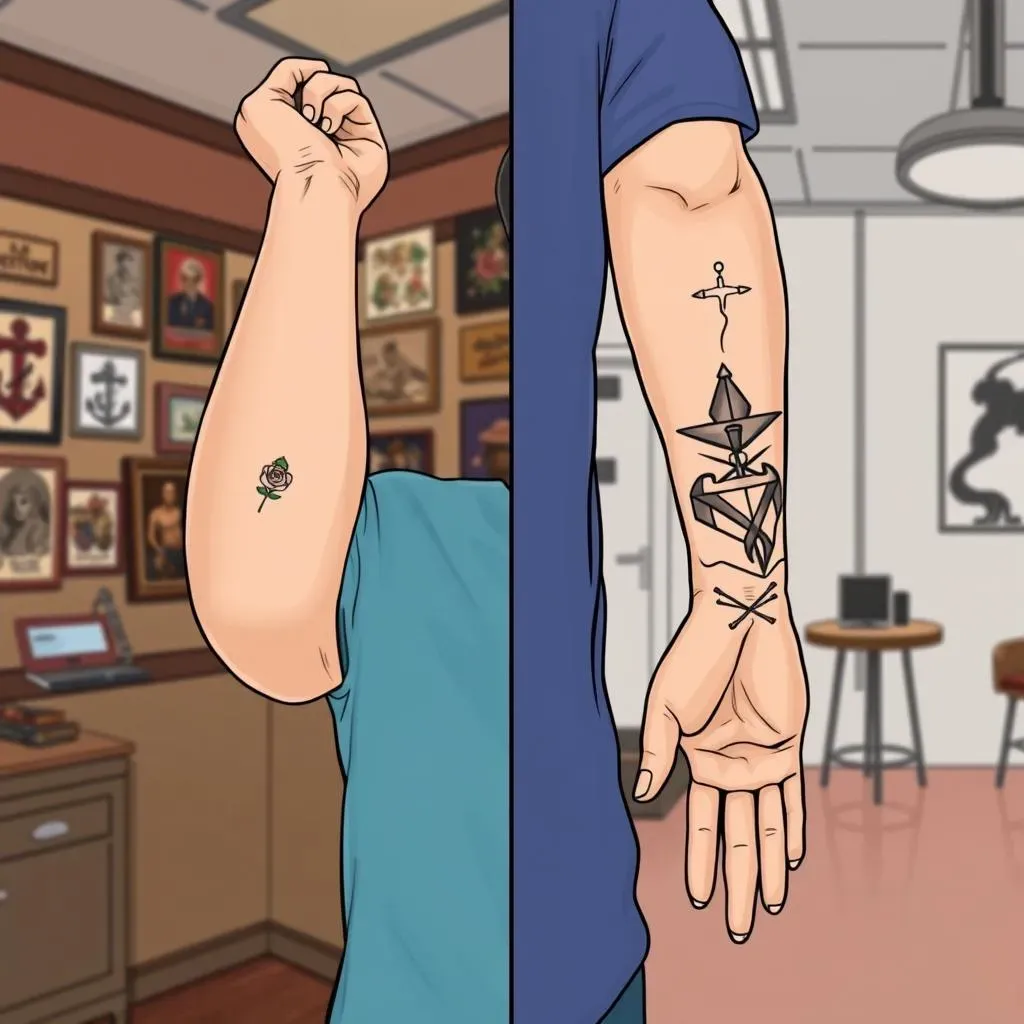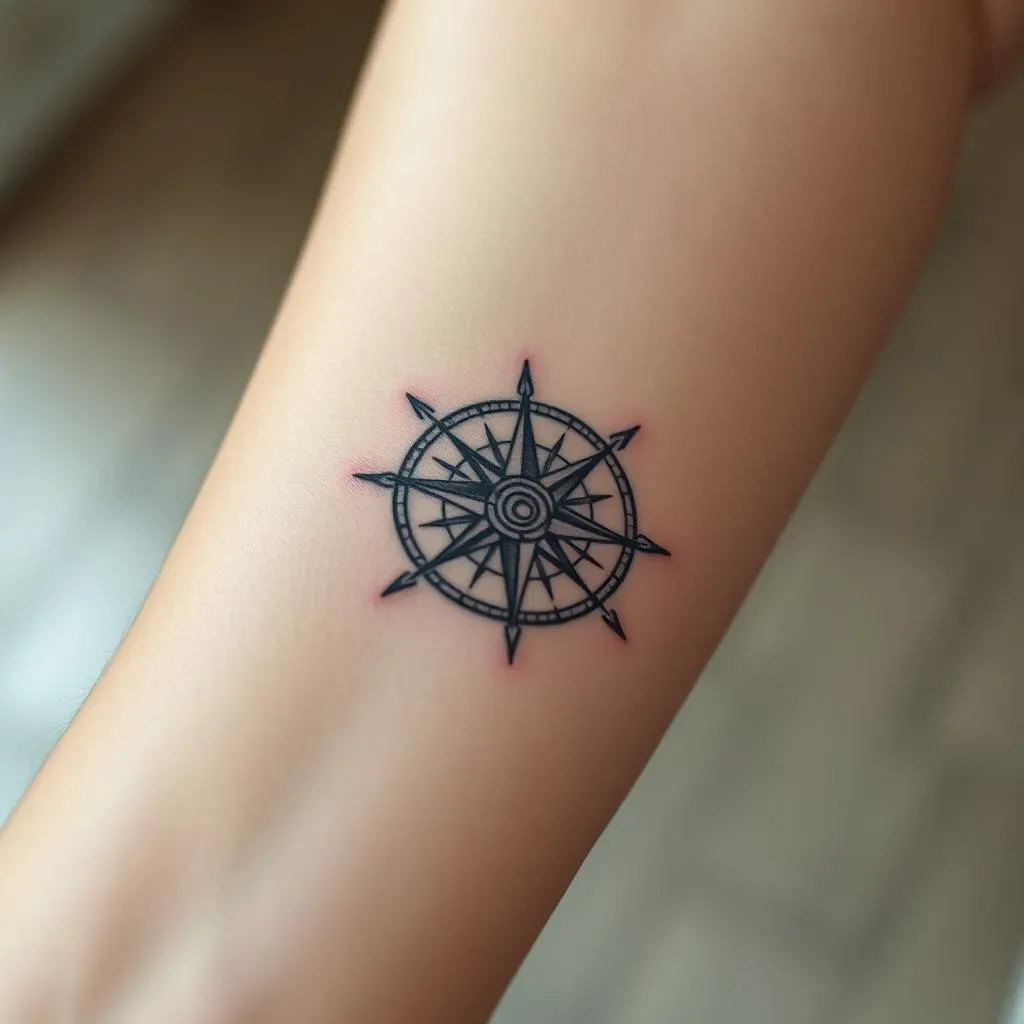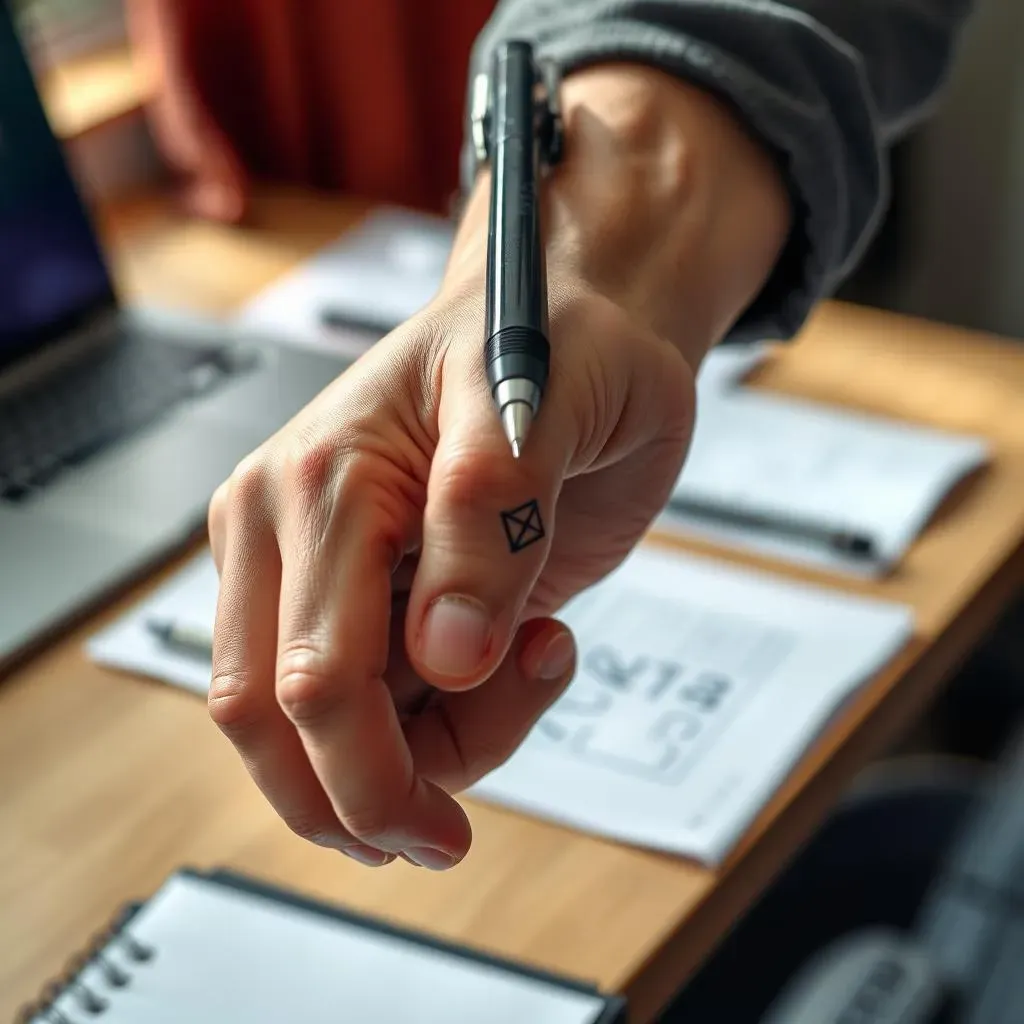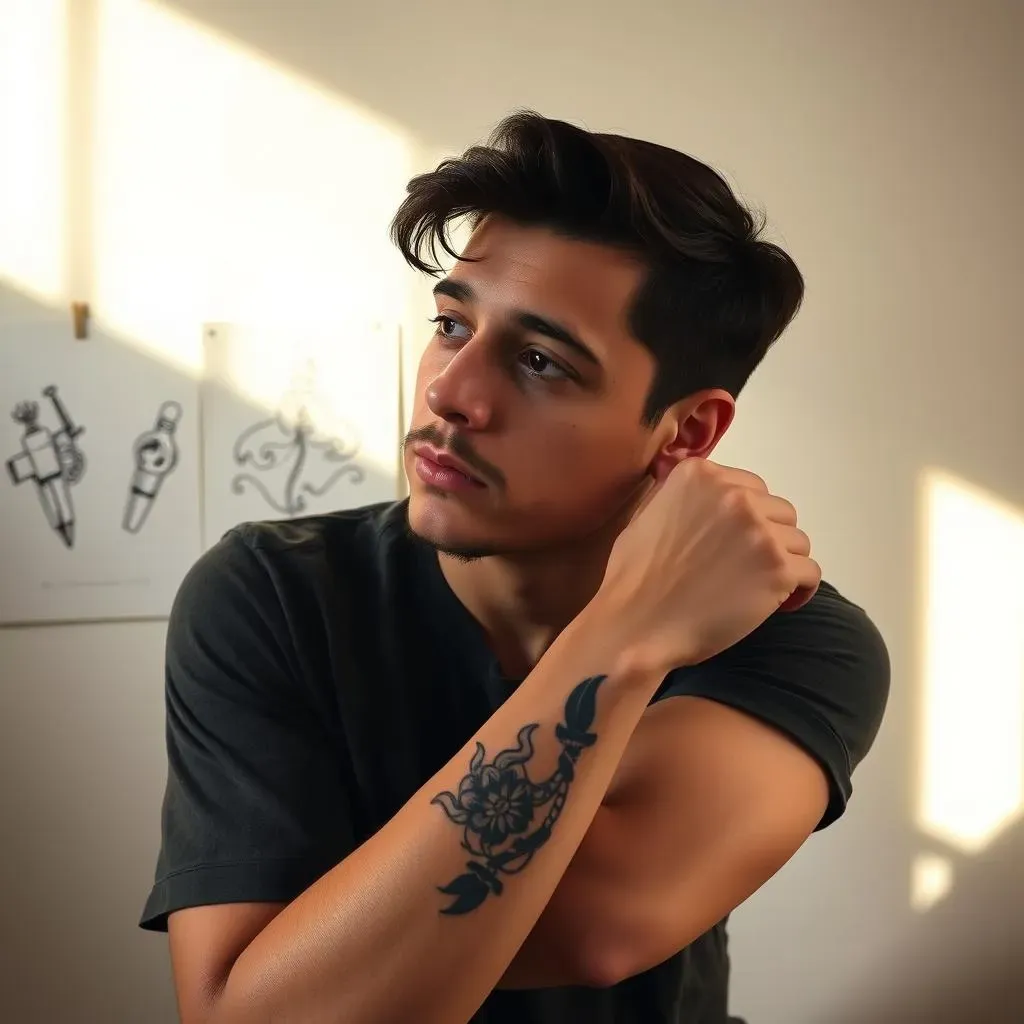Table of Contents
Ever looked at a tattoo and wondered, "Wait, is that upside down?" You're not alone. The question of whether a tattoo can be upside down pops up more than you'd think, especially with the rise of personal expression through body art. Forget the stuffy rules; when it comes to tattoos, it's mostly about what you like. This article will look at the idea of tattoo orientation, asking directly: can a tattoo be upside down? We'll explore traditional viewpoints on tattoo direction, and then we'll dive into how personal preference and modern tattoo culture have changed the game. You'll hear real stories about people rocking their upside down tattoos, and get some solid advice if you're thinking about getting one yourself. So, buckle up, let's get into the world of tattoos, where sometimes, upside down is just right.
The "Right" Way Up: Tattoo Orientation Basics
The "Right" Way Up: Tattoo Orientation Basics
Tattoo Traditions: A Look Back
so before we get into the wild world of upside down ink, let's peek at the old-school ideas about tattoo direction. Traditionally, tattoos were often placed to "face" the body. What does that even mean? Think of it this way: if you've got a design on your arm, the top of the image would point towards your head and the bottom towards your hand. It’s like the tattoo is looking at you when your arm is at your side. This idea comes from the thought that tattoos should flow with the natural lines of the body, not against them. It was all about creating a cohesive look, making the tattoo feel like a part of you, not just something stuck on.
There were even guidelines, like tattoos on the legs or arms facing inwards, towards the center of your body - your heart, some would say. This wasn't just about aesthetics either. Some cultures believed that the direction of a tattoo could affect its meaning or power. For instance, a symbol facing upwards might be associated with growth or rising above challenges, while one facing downwards could represent grounding or connection to the earth. It's fascinating how much intention could be packed into the simple act of choosing which way a tattoo faced. But here's the thing: those were just guidelines, not hard rules.
Traditional Tattoo Orientation | Reasoning |
|---|---|
Tattoos face inward, toward the body's center | Creates a cohesive look, follows body's natural lines |
Upright on arms and legs when at rest | Design is oriented to be viewed upright when the limb hangs naturally |
Considered symbolic meaning based on direction | Upward could mean growth, downward could mean grounding |
Modern Times: Breaking the Mold
Fast forward to today, and things are way more flexible. The old "rules" about tattoo direction? They're more like suggestions now. Modern tattoo culture is all about individuality. It’s about what you want, not what some old book says you should do. People are getting tattoos facing every direction imaginable, and honestly, it looks awesome. You see tattoos on arms facing towards the hand, or even sideways. It is an expression of the person, so it can be whatever they want. This shift happened because people realized that tattoos are personal. They're a way to show off your personality, your story, your style—and sometimes, that means flipping the script, or the tattoo, so to speak.
Today, tattoo artists are usually happy to work with your vision, whatever it is. They know that at the end of the day, it’s your skin and your choice, so if you want an upside down tattoo, they'll usually be more than happy to do it, and they will make it look good. This doesn't mean that the old traditions are totally gone though. Some people still feel a connection to those ideas, and that's perfectly fine. The real takeaway here is that the "right" way up is whatever feels right to you.
Can a Tattoo Be Upside Down? It's Your Body, Your Choice
Can a Tattoo Be Upside Down? It's Your Body, Your Choice
Your Rules, Your Skin
Let's get real for a second: it's your skin, your story, and your tattoo. So, can a tattoo be upside down? Absolutely! The idea that there's a "right" way up for a tattoo is pretty old-fashioned. Think of tattoos like clothes – you wear them the way you want. If you want a design that faces you, or sideways, or even upside down, that's totally fine. It's about expressing yourself, not following some made-up rules from way back when. It doesn’t matter what anyone else thinks, it is your body and you should do what you want with it.
The beauty of tattoos today is that they're a form of personal art. It's like you're walking around with a custom piece that only you can truly own. And just like any form of art, there shouldn't be any strict rules about how it should look to other people. If you're worried about what others might think about an upside down tattoo, remember that those people are probably not the ones who will truly appreciate your ink. It’s like choosing a favorite color – some people will love it, some might not get it, but it's your choice.
Why People Go Upside Down
So, why would someone choose an upside down tattoo? Well, there are tons of reasons. Some people like the way it looks on their body. A design might flow better or look more dynamic when it’s not facing the "traditional" way. Others might choose it for a symbolic meaning. Maybe an upside down symbol means something special to them, like a reminder to see things differently or a symbol of rebellion. Some people want to see it right-side up for themselves. If you have a tattoo on your wrist, for example, you might want it to look right-side up when you look at it.
And let's not forget the simple fact that it's just different. In a world where everyone is trying to stand out, an upside down tattoo can be a way to do that. It's a conversation starter, a way to show that you’re not afraid to go against the grain. It's like wearing a hat backwards – it's a little rebellious, a little playful, and definitely makes a statement. So, next time you see an upside down tattoo, don't assume it's a mistake. It's probably a thoughtful and intentional choice.
Reason for Upside Down Tattoos | Explanation |
|---|---|
Aesthetics | The design looks better or flows better with the body. |
Symbolic Meaning | The orientation carries a unique message or reminder. |
Personal preference | The wearer prefers to see it right-side up for themselves. |
Individuality | A way to be different and express oneself. |
Your Tattoo, Your Story
At the end of the day, the most important thing about your tattoo is what it means to you. It's not about what other people think, or what some old rulebook says. It’s about telling your story in a way that feels authentic. If an upside down tattoo is part of that story, then that’s exactly what you should get. Don’t let anyone else tell you how your art should look. It’s your body, your choice, and your story to tell.
So, go forth, get inked, and don't be afraid to flip the script—or the tattoo. After all, sometimes the most interesting and meaningful things in life are the ones that go against the flow. Remember, your body is a canvas, and you're the artist. There is no right or wrong way, just your way. If it feels right, then it is the right way.
RealWorld Examples: Upside Down Tattoos and Their Stories
RealWorld Examples: Upside Down Tattoos and Their Stories
The Wrist Watch: A Personal Perspective
Let's talk about wrists for a second, a super popular spot for tattoos, and a perfect example for our upside down chat. Think about it, when you're just hanging out, your hands are usually by your side, or maybe you're holding a cup of coffee or scrolling on your phone. Now, if you have a tattoo on your wrist that faces "upwards" in the traditional sense (towards your head), it's actually upside down from your own point of view. It's like that friend who always wears their hat backwards – it looks right to them, but not to everyone else. Some people get wrist tattoos "upside down" so that when they look at their wrist, they see it the right way. It’s about personal comfort and how you experience your own body art.
I remember this one person at the coffee shop, they had this amazing small geometric design on their wrist. It was facing down, and when I asked them about it, they said they got it that way so they can see it right side up when they are working at their desk. It was a small reminder that they were working towards their goals, and by having it face them, it made it feel more personal and powerful. It was fascinating how a simple change in direction could create such a different meaning for them. It was a good reminder that tattoos are personal to each person, and to not judge by what others do.
The Ankle Anchor: A Symbol of Grounding
Now, let's move down south a bit, to the ankles. Ankle tattoos are another great example of how the "rules" of tattoo direction get tossed out the window. You see a lot of ankle tattoos facing "down" toward the foot. Now, according to traditional ideas, that might seem a little odd, but it makes perfect sense. For some people, a tattoo facing downward symbolizes being grounded, connected to the earth, and a strong foundation. It's like having an anchor, keeping you steady, and it makes sense to have that anchor pointing down towards the earth below.
I once met someone who had a small, intricately detailed anchor tattooed on their ankle, and it was facing downwards. When I asked about the unusual direction, they shared that it was a reminder of their roots, their family, and where they came from. It wasn't just a pretty picture; it was a symbol of their personal journey, a way to keep their feet on the ground, both literally and figuratively. It was a powerful reminder that tattoos can be more than just ink on skin, they can be a way to carry your story with you, and sometimes, turning things upside down can make that story even more profound.
Tattoo Location | Common Upside Down Orientation | Reasoning |
|---|---|---|
Wrist | Facing down toward the hand | Appears right-side up to the wearer when they look at their wrist. |
Ankle | Facing down toward the foot | Symbolizes grounding, connection to the earth, and personal roots. |
Forearm | Facing toward the hand | Allows the wearer to view the tattoo right-side up when their arm is extended. |
Thinking of an Upside Down Tattoo? Things to Consider
Thinking of an Upside Down Tattoo? Things to Consider
Personal Visibility: How Will You See It?
so you're thinking about flipping your tattoo, huh? That's awesome! But before you jump into the chair, let's think about how you're going to see it every day. If you get a tattoo on your wrist, and you want to see it right-side up when you look at your wrist, then you'll want it to face your hand. If you get it facing the other way, it will look upside down to you. Same goes for other spots on your body. Think about your day-to-day activities, and how the tattoo will look to you in those moments. It's all about making sure you're happy with your personal viewing experience. After all, you're the one who has to live with it, so it should be something you enjoy seeing.
Consider also where other people will see it. If you want to get a tattoo on your arm, and you want it to look right-side up to others, then you might want to get it facing up. However, if you want it to be right-side up for you, it will be upside down to others. There is no right or wrong way to get a tattoo, but it is something you should think about before getting it done. It’s like choosing a piece of furniture for your home – you want it to look good in your space, from your perspective.
The Artist's Perspective: Communicate Clearly
When you go to your tattoo artist, it is important to clearly explain what you want. Don’t just say you want an upside down tattoo, explain why you want it, and how you want it to look on your body. The more clear you are, the better they can help you. This is especially true if you have a complex design, or if you want it in a specific spot, or if you want it to face a certain way. Most tattoo artists are happy to work with you to achieve your vision. They've seen it all, and they're usually excited to try new things. However, they're not mind readers, so it's up to you to communicate your vision clearly.
Some artists might have their own style or way of working, but a good artist will always prioritize what you want. They'll be able to tell you if your idea is feasible, if there are any risks, or if there are any better ways to do it. Remember, they're the experts, so listen to their advice, but also stand up for what you want. It’s like going to a chef with a specific recipe in mind – you want them to understand your vision, but you're also open to their expertise.
Consideration | Details |
|---|---|
Personal Viewing | How the tattoo will look to you in your daily life. |
Artist Communication | Clearly explain your vision to your artist. |
Symbolism | If the upside down orientation carries a specific meaning. |
Placement | How the tattoo will look on the specific part of your body. |
Symbolism and Meaning: It's All About You
Finally, let's talk about the meaning behind your upside down tattoo. If you're choosing to go against the traditional direction, it's worth considering why you're doing it. Does it have a personal meaning for you? Does it represent something you believe in? Does it help you tell your story? Maybe an upside down symbol represents rebellion, or maybe it’s a reminder to always see things from a different perspective. Maybe it's just because you like the way it looks, and that's totally valid too.
The beauty of tattoos is that they're a way to express your individuality. They're a way to tell the world who you are, what you believe in, and what you've been through. If you're going to get an upside down tattoo, make sure it's something you really connect with. It's like choosing a piece of art for your wall – you want it to be something that speaks to you, that makes you feel good, and that tells your story. So, think about the meaning behind your tattoo, and make sure it's something that's true to you.
Wrapping it Up: Upside Down and All Around
So, can a tattoo be upside down? Absolutely. The "rules" about tattoo orientation are more like guidelines, and honestly, they're pretty flexible. What matters most is that you love your ink and that it reflects your personality. Whether you choose to follow traditional placement or flip the script, it's your body and your story to tell. If you're considering an upside down design, think it through, chat with your artist, and then go for it. After all, tattoos are about expressing yourself, and sometimes, the best way to do that is to turn things on their head.